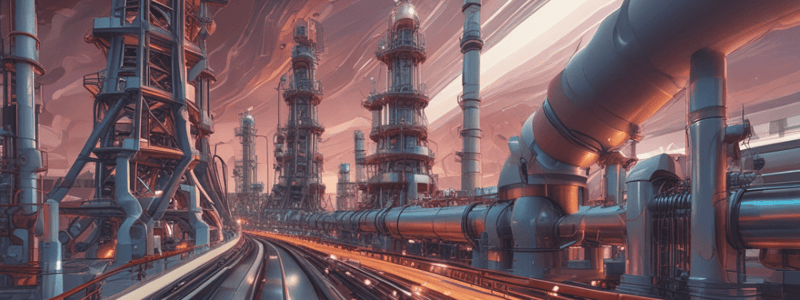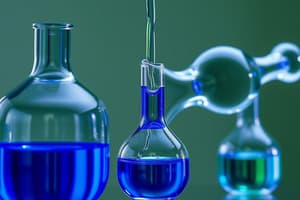Podcast
Questions and Answers
What is the significance of proximate analysis of coal?
What is the significance of proximate analysis of coal?
- To determine the physical properties of coal
- To determine the moisture content of coal (correct)
- To determine the energy content of coal
- To determine the exact chemical composition of coal
What is the unit of calorific value?
What is the unit of calorific value?
- J/g
- KCal/kg
- KJ/mol
- KJ/kg (correct)
What is the purpose of cracking of petroleum fractions?
What is the purpose of cracking of petroleum fractions?
- To increase the octane number of gasoline
- To produce gasoline and diesel from crude oil (correct)
- To produce petroleum jelly
- To decrease the cetane number of diesel
What is the effect of knocking in an IC engine?
What is the effect of knocking in an IC engine?
What is the characteristic of a good fuel?
What is the characteristic of a good fuel?
What is the difference between gross calorific value and net calorific value?
What is the difference between gross calorific value and net calorific value?
Which of the following is NOT a characteristic of a good fuel?
Which of the following is NOT a characteristic of a good fuel?
What is the purpose of cracking of petroleum fractions?
What is the purpose of cracking of petroleum fractions?
What is the significance of ultimate analysis of coal?
What is the significance of ultimate analysis of coal?
What is the relation between octane number and knocking in an IC engine?
What is the relation between octane number and knocking in an IC engine?
What is the primary reason for the difference between gross and net calorific values of a fuel?
What is the primary reason for the difference between gross and net calorific values of a fuel?
A fuel with a high cetane number is likely to have a
A fuel with a high cetane number is likely to have a
In a combustion reaction, if the volume of air supplied is less than the theoretical volume, the reaction is said to be
In a combustion reaction, if the volume of air supplied is less than the theoretical volume, the reaction is said to be
A fuel with a high octane number is more resistant to
A fuel with a high octane number is more resistant to
In a combustion reaction, the mass-to-mass stoichiometry is typically expressed in terms of
In a combustion reaction, the mass-to-mass stoichiometry is typically expressed in terms of
Which of the following is a characteristic of gasoline in an IC engine?
Which of the following is a characteristic of gasoline in an IC engine?
What is the purpose of ultimate analysis of coal?
What is the purpose of ultimate analysis of coal?
In a combustion reaction, what happens when the volume of air supplied is less than the theoretical volume?
In a combustion reaction, what happens when the volume of air supplied is less than the theoretical volume?
Which of the following is a result of knocking in an IC engine?
Which of the following is a result of knocking in an IC engine?
What is the relation between cetane number and fuel ignition?
What is the relation between cetane number and fuel ignition?
Flashcards are hidden until you start studying
Study Notes
Chemical Fuels
- Classified into solid, liquid, and gaseous fuels based on their physical state
- Calorific value: a measure of the energy content of a fuel
- Gross calorific value: the total energy released when a unit of fuel is burned
- Net calorific value: the available energy released when a unit of fuel is burned, considering the water produced during combustion
Analysis of Coal
- Proximate analysis: determines the percentage of moisture, volatile matter, fixed carbon, and ash in coal
- Ultimate analysis: determines the percentage of carbon, hydrogen, oxygen, nitrogen, and sulfur in coal
- Significance of coal analysis: helps in determining the quality and suitability of coal for various applications
Characteristics of Good Fuel
- High energy density
- Easy to handle and store
- Low water content
- Low sulfur content
- Low ash content
- Easy to ignite and burn
Cracking of Petroleum Fractions
- Cracking: a process of breaking down large molecules into smaller ones
- Used to produce gasoline, diesel, and other petroleum products
- Cracking of petroleum fractions: involves the breakdown of large molecules into smaller ones to produce useful products
Use of Gasoline and Diesel in IC Engines
- Gasoline: used in spark ignition engines
- Diesel: used in compression ignition engines
- Difference in combustion process: spark ignition in gasoline engines, compression ignition in diesel engines
Knocking, Octane Number, and Cetane Number
- Knocking: a phenomenon where fuel ignites prematurely in an engine, leading to engine damage
- Octane number: a measure of a fuel's resistance to knocking, with higher numbers indicating higher resistance
- Cetane number: a measure of a fuel's ignition quality, with higher numbers indicating better ignition quality
Combustion Calculations
- Mass to mass calculations: involve calculating the amount of air required for combustion based on the mass of fuel
- Volume to volume calculations: involve calculating the amount of air required for combustion based on the volume of fuel
- Less air supplied type: involves calculating the amount of air required for combustion when less air is available than the stoichiometric amount
Chemical Fuels
- Classified into solid, liquid, and gaseous fuels based on their physical state
- Calorific value: a measure of the energy content of a fuel
- Gross calorific value: the total energy released when a unit of fuel is burned
- Net calorific value: the available energy released when a unit of fuel is burned, considering the water produced during combustion
Analysis of Coal
- Proximate analysis: determines the percentage of moisture, volatile matter, fixed carbon, and ash in coal
- Ultimate analysis: determines the percentage of carbon, hydrogen, oxygen, nitrogen, and sulfur in coal
- Significance of coal analysis: helps in determining the quality and suitability of coal for various applications
Characteristics of Good Fuel
- High energy density
- Easy to handle and store
- Low water content
- Low sulfur content
- Low ash content
- Easy to ignite and burn
Cracking of Petroleum Fractions
- Cracking: a process of breaking down large molecules into smaller ones
- Used to produce gasoline, diesel, and other petroleum products
- Cracking of petroleum fractions: involves the breakdown of large molecules into smaller ones to produce useful products
Use of Gasoline and Diesel in IC Engines
- Gasoline: used in spark ignition engines
- Diesel: used in compression ignition engines
- Difference in combustion process: spark ignition in gasoline engines, compression ignition in diesel engines
Knocking, Octane Number, and Cetane Number
- Knocking: a phenomenon where fuel ignites prematurely in an engine, leading to engine damage
- Octane number: a measure of a fuel's resistance to knocking, with higher numbers indicating higher resistance
- Cetane number: a measure of a fuel's ignition quality, with higher numbers indicating better ignition quality
Combustion Calculations
- Mass to mass calculations: involve calculating the amount of air required for combustion based on the mass of fuel
- Volume to volume calculations: involve calculating the amount of air required for combustion based on the volume of fuel
- Less air supplied type: involves calculating the amount of air required for combustion when less air is available than the stoichiometric amount
Chemical Fuels
- Classified into solid, liquid, and gaseous fuels based on their physical state
- Calorific value: a measure of the energy content of a fuel
- Gross calorific value: the total energy released when a unit of fuel is burned
- Net calorific value: the available energy released when a unit of fuel is burned, considering the water produced during combustion
Analysis of Coal
- Proximate analysis: determines the percentage of moisture, volatile matter, fixed carbon, and ash in coal
- Ultimate analysis: determines the percentage of carbon, hydrogen, oxygen, nitrogen, and sulfur in coal
- Significance of coal analysis: helps in determining the quality and suitability of coal for various applications
Characteristics of Good Fuel
- High energy density
- Easy to handle and store
- Low water content
- Low sulfur content
- Low ash content
- Easy to ignite and burn
Cracking of Petroleum Fractions
- Cracking: a process of breaking down large molecules into smaller ones
- Used to produce gasoline, diesel, and other petroleum products
- Cracking of petroleum fractions: involves the breakdown of large molecules into smaller ones to produce useful products
Use of Gasoline and Diesel in IC Engines
- Gasoline: used in spark ignition engines
- Diesel: used in compression ignition engines
- Difference in combustion process: spark ignition in gasoline engines, compression ignition in diesel engines
Knocking, Octane Number, and Cetane Number
- Knocking: a phenomenon where fuel ignites prematurely in an engine, leading to engine damage
- Octane number: a measure of a fuel's resistance to knocking, with higher numbers indicating higher resistance
- Cetane number: a measure of a fuel's ignition quality, with higher numbers indicating better ignition quality
Combustion Calculations
- Mass to mass calculations: involve calculating the amount of air required for combustion based on the mass of fuel
- Volume to volume calculations: involve calculating the amount of air required for combustion based on the volume of fuel
- Less air supplied type: involves calculating the amount of air required for combustion when less air is available than the stoichiometric amount
Chemical Fuels
- Classified into solid, liquid, and gaseous fuels based on their physical state
- Calorific value: a measure of the energy content of a fuel
- Gross calorific value: the total energy released when a unit of fuel is burned
- Net calorific value: the available energy released when a unit of fuel is burned, considering the water produced during combustion
Analysis of Coal
- Proximate analysis: determines the percentage of moisture, volatile matter, fixed carbon, and ash in coal
- Ultimate analysis: determines the percentage of carbon, hydrogen, oxygen, nitrogen, and sulfur in coal
- Significance of coal analysis: helps in determining the quality and suitability of coal for various applications
Characteristics of Good Fuel
- High energy density
- Easy to handle and store
- Low water content
- Low sulfur content
- Low ash content
- Easy to ignite and burn
Cracking of Petroleum Fractions
- Cracking: a process of breaking down large molecules into smaller ones
- Used to produce gasoline, diesel, and other petroleum products
- Cracking of petroleum fractions: involves the breakdown of large molecules into smaller ones to produce useful products
Use of Gasoline and Diesel in IC Engines
- Gasoline: used in spark ignition engines
- Diesel: used in compression ignition engines
- Difference in combustion process: spark ignition in gasoline engines, compression ignition in diesel engines
Knocking, Octane Number, and Cetane Number
- Knocking: a phenomenon where fuel ignites prematurely in an engine, leading to engine damage
- Octane number: a measure of a fuel's resistance to knocking, with higher numbers indicating higher resistance
- Cetane number: a measure of a fuel's ignition quality, with higher numbers indicating better ignition quality
Combustion Calculations
- Mass to mass calculations: involve calculating the amount of air required for combustion based on the mass of fuel
- Volume to volume calculations: involve calculating the amount of air required for combustion based on the volume of fuel
- Less air supplied type: involves calculating the amount of air required for combustion when less air is available than the stoichiometric amount
Studying That Suits You
Use AI to generate personalized quizzes and flashcards to suit your learning preferences.





